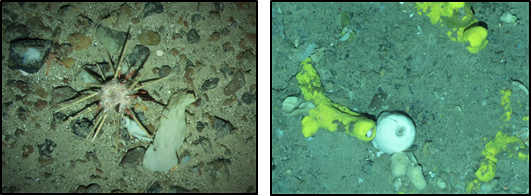Sid the stonecrab left the house early today to get a head start on his early morning seabed scavenge. At these depths there is no natural light, the water is clear and nearly as cold as that at the poles. The seabed here is not barren, however... far from it. Sid passes through areas thick with a variety of deep sea sponges growing in fantastic forms and sizes as he forages. The area supports a variety of other animals too like cushion stars, brittle stars, pencil urchins, anemones, squat lobsters and fish like ling, torsk and deep sea red fish.
Suddenly, a brightness he has never seen before descends from
above, stopping just metres away from him. The brightly lit metallic object pauses
for only a moment before moving on, bobbing along its way in the deep. Little
does Sid know that hundreds of meters above him, the Marine Research Vessel
Scotia is carrying out an extensive survey of the sponge grounds that are his home.
In a joint operation, JNCC and Marine Scotland Science (MSS) have been
surveying the North-east Faroe-Shetland Channel Nature Conservation Marine
Protected Area (NEF NCMPA) for the last week as part of the UK’s MPA
monitoring.
Now that the storm on the surface has abated, the sea is
again calm enough to resume survey operations. The joint survey team have been
collecting video and photographs of the seabed for the last 36 hours using a
dropframe camera system. The sophisticated camera systems are repeatedly lowered
off the back of the ‘Scotia’ into the deep in search of their quarry: the deep-sea
sponges and their associated animals, including Sid (much to his surprise!).
The intrepid crew, a mixture of professional seamen and scientists, will keep
up this work twenty-four hours a day until they have collected enough footage
to form a picture of this little-known area of seabed. This work will help to better understand and protect Sid’s
home among the amazing deep-sea sponges of the Northern North Sea.
To find out more information about North-East Faroe Shetland Channel, check out the JNCC Site Information Centre.
For more updates from the team, make sure to follow @JNCC_UK on twitter and this blog by entering your email address on the right hand side of the screen.
Written by Henk van Rein
Seabed images copyright JNCC/MSS.
Non-seabed images copyright Henk van Rein/JNCC.


